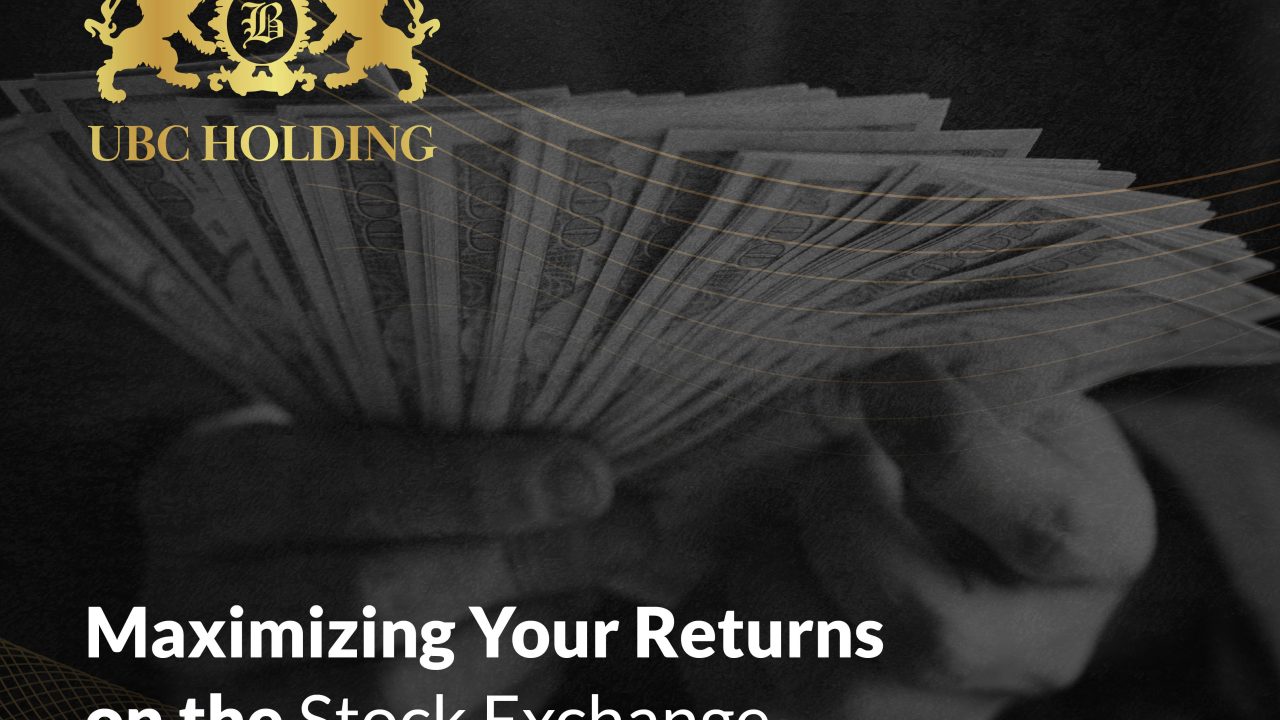Investing in the stock market has long been a popular method for individuals to grow their wealth and achieve financial independence. Yet, the complexity and volatility of the stock market can be daunting for many. How can you effectively maximize your returns on the stock exchange? In this comprehensive guide, we’ll explore strategies, tips, and insights to help you navigate the stock market successfully. Our focus keyword, “Returns on the Stock Exchange,” will be integrated throughout the article to ensure a robust understanding of how to optimize your investments.
Understanding the Basics

What Are Returns on the Stock Exchange?
Returns on the stock exchange refer to the profit or loss you make from investing in stocks. This can come in the form of capital gains, which are profits from selling stocks at a higher price than you paid for them, and dividends, which are regular payments made by companies to their shareholders from their profits.
Why Focus on Returns?
Maximizing returns on the stock exchange is crucial because it directly impacts your overall wealth accumulation and financial goals. Whether you’re saving for retirement, a major purchase, or simply growing your investment portfolio, understanding how to maximize returns can make a significant difference.
Strategies to Maximize Returns
Diversification
Diversification is one of the most effective ways to maximize returns on the stock exchange while minimizing risk. By spreading your investments across various sectors, industries, and geographical regions, you can reduce the impact of a poor-performing investment on your overall portfolio.
- Sector Diversification: Invest in different sectors like technology, healthcare, and finance to spread risk.
- Geographical Diversification: Include international stocks to hedge against domestic market volatility.
- Asset Diversification: Combine stocks with other assets like bonds, real estate, and commodities.
Long-Term Investing
Taking a long-term approach to investing can significantly enhance your returns on the stock exchange. While short-term trading can be profitable, it often involves higher risks and transaction costs. Long-term investing allows you to ride out market volatility and benefit from compound growth.
- Buy and Hold Strategy: Invest in high-quality stocks and hold them for an extended period.
- Reinvest Dividends: Automatically reinvest dividends to benefit from compounding.
Fundamental Analysis
Fundamental analysis involves evaluating a company’s financial health, management, industry position, and growth prospects. By conducting thorough research, you can identify undervalued stocks that have the potential to deliver strong returns on the stock exchange.
- Financial Statements: Analyze income statements, balance sheets, and cash flow statements.
- Management Quality: Assess the experience and track record of the company’s management team.
- Industry Trends: Understand the competitive landscape and future growth potential of the industry.
Technical Analysis
Technical analysis focuses on historical price and volume data to predict future stock movements. By identifying patterns and trends, you can make more informed decisions about when to buy and sell stocks to maximize your returns on the stock exchange.
- Charts and Indicators: Use tools like moving averages, relative strength index (RSI), and Bollinger Bands.
- Trend Analysis: Identify upward, downward, and sideways trends to time your trades.
Staying Informed
Keeping up with market news, economic indicators, and geopolitical events is essential for maximizing your returns on the stock exchange. Staying informed allows you to react quickly to changes and adjust your investment strategy accordingly.
- Financial News: Follow reputable financial news sources and analysts.
- Economic Indicators: Monitor key indicators like GDP growth, unemployment rates, and inflation.
- Geopolitical Events: Understand how global events impact the stock market.
Advanced Strategies for Higher Returns

Value Investing
Value investing involves selecting stocks that appear to be undervalued by the market. By investing in companies that are trading below their intrinsic value, you can achieve higher returns on the stock exchange when the market eventually recognizes their true worth.
- Price-to-Earnings (P/E) Ratio: Look for stocks with low P/E ratios compared to their peers.
- Book Value: Invest in companies trading below their book value.
- Dividend Yield: Focus on stocks with high and stable dividend yields.
Growth Investing
Growth investing focuses on companies with high potential for future growth. While these stocks may be more volatile, they offer the opportunity for significant returns on the stock exchange.
- Revenue and Earnings Growth: Look for companies with strong historical and projected growth rates.
- Innovation and Market Position: Invest in companies that are leaders in their industries and have a track record of innovation.
- Scalability: Choose companies with scalable business models that can grow rapidly.
Dividend Investing
Dividend investing involves selecting stocks that pay regular dividends. This strategy provides a steady income stream and can enhance your returns on the stock exchange through both dividend payments and capital appreciation.
- Dividend Yield: Look for stocks with attractive dividend yields.
- Dividend Growth: Focus on companies with a history of increasing their dividends.
- Payout Ratio: Ensure the company has a sustainable payout ratio, typically below 60%.
Momentum Investing
Momentum investing involves buying stocks that have shown an upward price trend and selling those with downward trends. By capitalizing on market momentum, you can achieve higher returns on the stock exchange.
- Relative Strength: Invest in stocks with strong relative strength compared to the market.
- Trend Following: Use moving averages and other indicators to identify trending stocks.
- Risk Management: Implement stop-loss orders to limit potential losses.
Risk Management Techniques

Diversification Revisited
While diversification is a strategy for maximizing returns, it is also a crucial risk management tool. By spreading your investments, you can mitigate the impact of a poor-performing asset on your overall portfolio.
Position Sizing
Position sizing involves determining the amount of capital to allocate to each investment. By managing the size of your positions, you can control risk and prevent any single investment from having a disproportionate impact on your returns on the stock exchange.
Stop-Loss Orders
Stop-loss orders automatically sell a stock when its price reaches a predetermined level. This technique helps protect your portfolio from significant losses and ensures that you maintain control over your investments.
Regular Portfolio Review
Regularly reviewing your portfolio allows you to assess your investments’ performance and make necessary adjustments. By staying proactive, you can identify potential issues and optimize your returns on the stock exchange.
- Performance Analysis: Compare your portfolio’s performance against benchmarks.
- Rebalancing: Adjust your asset allocation to maintain your desired risk level.
- Market Conditions: Adapt your strategy based on changing market conditions.
Psychological Aspects of Investing
Managing Emotions
Emotions like fear and greed can significantly impact your investment decisions. Managing these emotions is crucial for maximizing your returns on the stock exchange.
- Fear: Avoid panic selling during market downturns.
- Greed: Resist the temptation to chase after speculative investments.
- Discipline: Stick to your investment plan and avoid impulsive decisions.
Behavioral Biases
Understanding and mitigating behavioral biases can enhance your investment performance.
- Confirmation Bias: Avoid seeking information that only confirms your existing beliefs.
- Overconfidence: Be realistic about your abilities and avoid taking excessive risks.
- Loss Aversion: Recognize that losses are a part of investing and focus on long-term gains.
Developing a Strong Mindset
A strong mindset is essential for navigating the stock market successfully. By developing resilience and staying focused on your goals, you can achieve higher returns on the stock exchange.
- Patience: Be patient and give your investments time to grow.
- Persistence: Stay committed to your strategy, even during challenging times.
- Adaptability: Be willing to adapt your approach based on new information and changing market conditions.
Practical Tips for Maximizing Returns

Start Early
Starting early allows you to take advantage of compound growth. The earlier you start investing, the more time your investments have to grow, leading to higher returns on the stock exchange.
Automate Investments
Automating your investments through regular contributions and dividend reinvestments can help you stay disciplined and ensure consistent growth.
Minimize Fees
High fees can erode your returns on the stock exchange. Choose low-cost investment options, such as index funds and ETFs, to minimize fees and maximize your gains.
Stay Educated
Continuously educating yourself about the stock market, investment strategies, and financial planning is crucial for long-term success.
- Books and Courses: Read books and take courses on investing and finance.
- Mentors and Advisors: Seek guidance from experienced investors and financial advisors.
- Market Analysis: Regularly analyze market trends and investment opportunities.
Avoid Market Timing
Attempting to time the market can lead to missed opportunities and increased risk. Focus on a long-term investment strategy and avoid trying to predict short-term market movements.
FAQs
What are the key factors that influence returns on the stock exchange?
Several factors influence returns on the stock exchange, including market conditions, economic indicators, company performance, and investor sentiment. Understanding these factors can help you make informed investment decisions and maximize your returns.
How can I reduce risk while maximizing returns?
Diversification, position sizing, and stop-loss orders are effective risk management techniques that can help you reduce risk while maximizing returns on the stock exchange. Additionally, staying informed and managing your emotions are crucial for maintaining a balanced investment approach.
Is it better to invest in individual stocks or index funds?
Both individual stocks and index funds have their advantages. Investing in individual stocks allows for potentially higher returns through stock picking, while index funds offer diversification and lower risk. A balanced approach that includes both individual stocks and index funds can help you achieve optimal returns on the stock exchange.
How often should I review my investment portfolio?
Regularly reviewing your investment portfolio is essential for maintaining optimal performance. A quarterly or bi-annual review is typically sufficient, but you may need to review your portfolio more frequently during periods of significant market volatility or when your financial goals change.
What is the impact of taxes on returns?
Taxes can significantly impact your returns on the stock exchange. Understanding the tax implications of your investments and employing tax-efficient strategies, such as holding investments for the long term and using tax-advantaged accounts, can help you maximize your after-tax returns.
Conclusion
Maximizing your returns on the stock exchange requires a combination of sound investment strategies, effective risk management, and a strong mindset. By understanding the basics, employing advanced strategies, managing your emotions, and staying informed, you can navigate the stock market successfully and achieve your financial goals. Whether you’re a seasoned investor or just starting, the principles outlined in this guide can help you enhance your returns on the stock exchange and build a robust investment portfolio. Remember, the journey to financial success is a marathon, not a sprint. Stay patient, stay disciplined, and stay focused on your long-term goals.

